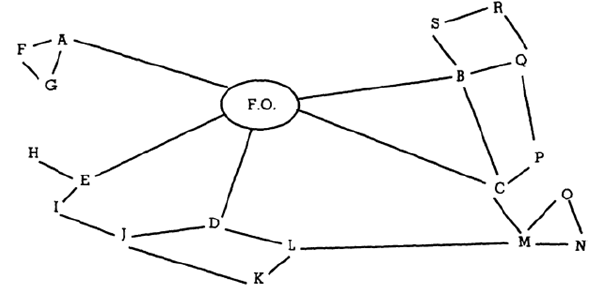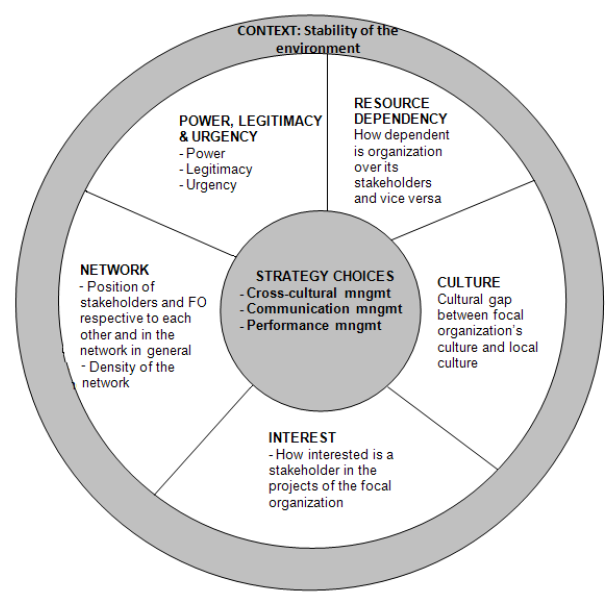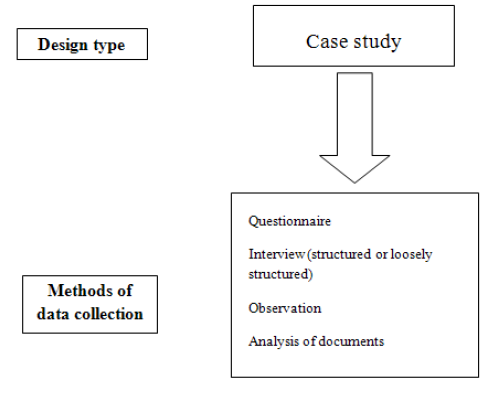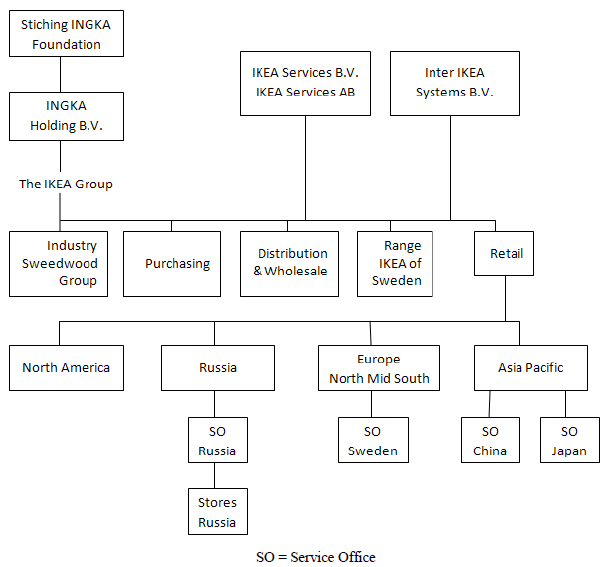ABSTRACT
Nowadays, an increasing number of global retailers such as IKEA, Carrefour and Auchan, are expanding their business internationally: internationalization is seen as a way to face competitors as well as to enhance position on the market. In particular, emerging markets are becoming a fertile field for investing resources due to their fast economic development and growing disposable income of the local population. A number of market actors (or stakeholders) affect or are affected by the internationalization process, and therefore stakeholder management determines its success to a large extent. Thus, stakeholder management competences are becoming increasingly important in today’s business world.
Our study addresses stakeholder management strategy applied by a Swedish global retailer (IKEA) when internationalizing to the Russian market. We also try to identify the main cultural differences between the focal organization and the Russian stakeholders, and the way in which the company faces and overcomes those diversities. Thus, we first give a brief overview of stakeholder management approach applied by IKEA on the corporate level, and then focus on particular practices adopted in Russia. Although the IKEA Group has internal and external stakeholder management framework, we find out that no explicit stakeholder management methodology is used in Russia. The strategy of managers is emergent and implicit, but within the company guidelines and code of conduct and in accordance with organizational culture and values.
Although we outline IKEA Russia’s interaction with all main stakeholder groups on the Russian market, we examine more in detail the strategies applied towards the company’s three most critical stakeholders: government, suppliers and employees. Hence, IKEA Russia opts for longterm close collaboration with suppliers through knowledge and expertise exchange, close relationship-building, improvement of working standards, and even financial investments in some cases.
Employees are granted good working conditions and respectful attitude, different compensation package, possibilities for personal and professional development. Government, identified by our respondents as the most challenging stakeholder, is approached through lobbying on different levels, development of personal relationships, exchange of experience and best practices. However, when interacting with authorities, IKEA also has to adapt, be “flexible within the limits”, and focus on the long-term.
Having outlined real-life strategies applied by IKEA in Russia, we compare them with the results of theoretical modeling. In order to come up with theoretical propositions for stakeholder management of IKEA in Russia, we developed a stakeholder management model, which comprised all the most relevant theories. We, thus, discover that theoretical suggestions for stakeholder management are close to what is done by management in practice. However, the theoretical model overlooks “soft” aspects of dealing with stakeholders: local and organizational culture, turbulent business environment, fast pace of doing business. Moreover, it is difficult for a single stakeholder management framework to give a one-right stakeholder management approach: it is important to combine different theories and use them for complementing each other. This allows to get a more profound insight into managing stakeholders.
We develop our research based on the information we could gather from IKEA’s representatives as well as secondary data sources, such as books, two doctoral theses, and a vast amount of journal articles. Our respondents were asked to answer questions throughout which their perceptions about the company’s stakeholders have been evaluated. This has helped the researchers to draw conclusions and answer the research questions.
RESEARCH METHODOLOGY
Introduction
This chapter discusses the research methodology that was applied in the present research thesis. The chapter will start by explaining the philosophical considerations of the study, continue with the brief description of the research strategy adopted and finalize with the research type chosen.
Research Philosophy
Understanding the philosophy of the study is important because it determines the research strategy and methods used to shape it (Saunders, Lewis, & Thornhill, 2007). This subchapter will deal with epistemological and ontological considerations, as well as explain the research approach applied in the study.
LITERATURE REVIEW
This chapter reviews the literature related to internationalization, stakeholder management and cross-cultural management theories and methodologies. We identify the main internationalization theories which, together with the description of the major cross-cultural management approaches, support the analysis of stakeholder management, the core topic of our research. Since internationalization strategy is the basic process organizations have to apply when they expand their business abroad, we start the literature review by briefly describing this process through the analysis of academic articles and books.
Subsequently, we narrow down our research and concentrate on the analysis of retailers’ internationalization and their expansion in the Russian market. After having delineated the main features of the internationalization process, we then focus in depth on examining stakeholder management. Without any doubt, cultural differences, compatibility of organizational culture with local norms and values are of extreme importance when it comes to both stakeholder management and expansion of firms in a foreign market (Waldman et al., 2006; Agle et al., 1999; Boesso & Kumar, 2009).
MODELS OF THE RESEARCH STUDY
Figure 1 represents the location model of our study: in it we tried to locate stakeholder management, main topic of our research, among other related matters and show their interdependence. Thus, stakeholder management, together with a number of other independent variables, determines the success of the internationalization process, which therefore is considered a dependent variable. However, the success or failure of stakeholder management is in turn shaped by other factors, cross-cultural management among them.

Figure 3. Network of an organization. Source: Rowley, 1997; p.891.
Rowley’s (1997) network approach (Figures 3 and 4). According to this approach the power of organization depends on its position in the network of stakeholders (centrality) and on density of this network. Thus, for example, if an organization holds a peripheral position and the network is not dense, then there is little possibility to influence stakeholders. Similarly, if the organization has a central position and the network is dense, then there is more opportunity to affect behavior of stakeholders.

Figure 8. Stakeholder management framework.
Having analyzed theories related to stakeholder management and having added some other aspects that we consider bottlenecks of stakeholder management, we developed a model (Figure 8) that characterizes the relationship between the company and its stakeholders, and therefore helps to make the most appropriate and suitable strategy choices. Our model is based on the kaleidoscope approach since we believe that this approach best captures the complexity of stakeholder management and relates it to everyday operations of the company.
RESEARCH DESIGN

Figure 9. Relationship between research design and methods of data collection.
Once we defined the strategy of our research, we chose the way in which data will be collected and analyzed. As Figure 9 shows, there are many methods of data collection that can be adopted when developing a case study. We chose interviewing as the approach that best satisfies the needs of our study (De Vaus, 2001). In particular, for two main reasons we decided to undertake focused open-ended semi-structured interviews, in which the respondents were asked to answer mainly the same type of questions.
COMBINED EMPIRICAL FINDINGS AND DATA ANALYSIS

Figure 10. Structure of the IKEA group of companies. Adapted from: Jonsson, 2008; p.105.
We start discussion about IKEA’s stakeholder network by presenting the structure of the IKEA group of companies. As can be seen from Figure 10, IKEA itself has a rather complex structure and a significant number of internal stakeholders. Thus, apart from managing local stakeholders at the market where the retailer is internationalizing, it has to pay enough attention and monitor the internal stakeholders.

Figure 13. IKEA and its Industrial Network. Source: Baraldi, 2008; p.100.
The relationships between IKEA and its suppliers are visually portrayed on Figure 13. This figure shows the whole Industrial Network of IKEA Group and the important role that suppliers play in it. Thus, the Network is exceptionally complex; it comprises around 1300 direct suppliers, about 10000 sub-suppliers, spread over 60 countries, as well as a big number of logistic partners (Baraldi, 2008).
CONCLUSIONS AND RECCOMENDATIONS
This chapter briefly summarizes the findings of our research and the conclusions that we drew out of it. The study has been undertaken with the purpose to analyze stakeholder strategies and practices applied by a global retailer when internationalizing to Russia, and whether these strategies are in accordance with theoretical propositions. Thus, we begin the chapter by answering the research questions that were formulated at the beginning of our study. Consequently, we provide some recommendations and list the main limitations of the research. We conclude by suggesting the possible future research directions.
According to one of respondents, The IKEA Group applies both internal and external stakeholder management frameworks. The former one is utilized in order to coordinate interaction and increase efficiency of the internal business units and companies within the IKEA network. The latter implies conducting of a thorough research about different countries, clustering them according to stakeholder similarities (customer behavior, government relations, suppliers, employees, business environment, and political system) and developing an internationalizing strategy which can be replicated in other cases.
However, in terms of Russia, due to the turbulent business environment and economic crisis during the year of IKEA’s entry to the Russian market, IKEA has never had any explicit stakeholder management strategy. Nevertheless, interaction with stakeholders is effective and consistent due to utilization of corporate guidelines and Code of Conduct. These guidelines cover different spheres of the company’s life and in the end determine the way it interacts with its stakeholders. Moreover, stakeholder management strategies depend heavily on the company’s unique and strong organizational culture and values.
Source: UMEA University
Authors: Dinara Izmaylova | Federica Zuccon

